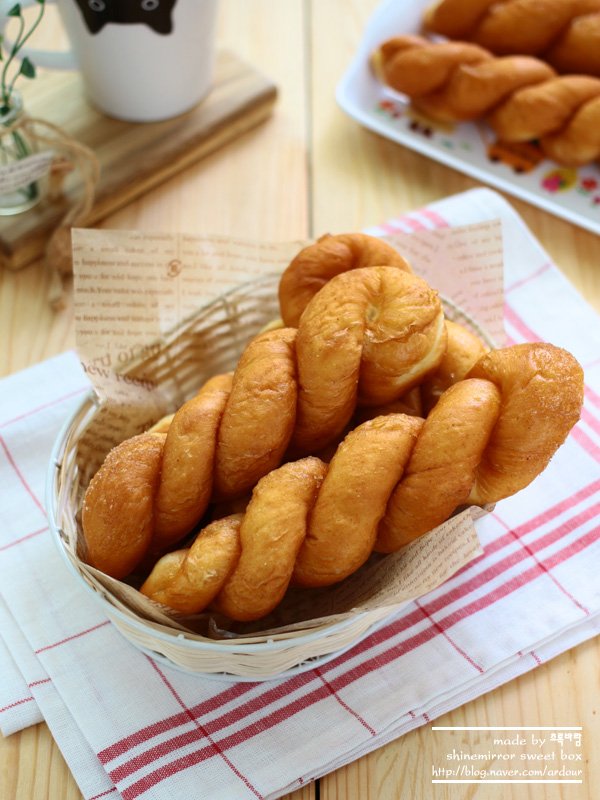
Delicious twisted doughnuts
The weather has gotten cooler, so stand in front of the fire and in front of the oven, come on~~
So I cooked fried food that was hard to imagine in summer.
I made a twisted doughnut that is by far the best in fried baking.
The taste that you eat when it's fried in oil
It's savory and soft. Delicious twisted doughnuts Let's make it^^
16 pieces
4 serving
Within 90 minutes
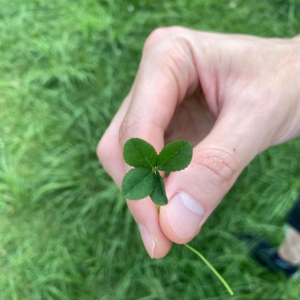
초록바람N
- Ingredients
-
-
Strong flour300g
-
Soft flour75g
-
Sugar35g
-
Butter45g
-
Salt1ts
-
skimmed milk powder10g
-
Eggs1ea
-
Instant Dryist2ts
-
Water165~175g
-
vanilla oillittle
-
nutmeglittle
-
Cooking oilsuitably
-
cinnamon powderlittle
-
Sugarlittle
-
- Cooking Steps
-
STEP 1/6Measure the powder so that the yeast, sugar, and salt do not touch the bowl. Add water and eggs except butter, knead at low speed, and when it lumps together, leave it at room temperature, add soft butter, and knead at medium speed. The amount of moisture can vary depending on the environmental condition, so adjust it appropriately and put it in. The dough is glossy and stretched a little, and if you stretch it out gently, the dough is complete. You just need to grab 100% of the gluten.
 STEP 2/6First fermentation in a warm place, please. If the hole stays the same when inflated by 2.5 to 3 times or stabbed with a finger, fermentation is complete. It took me about 40 minutes at a temperature of 35 to 38 degrees.
STEP 2/6First fermentation in a warm place, please. If the hole stays the same when inflated by 2.5 to 3 times or stabbed with a finger, fermentation is complete. It took me about 40 minutes at a temperature of 35 to 38 degrees.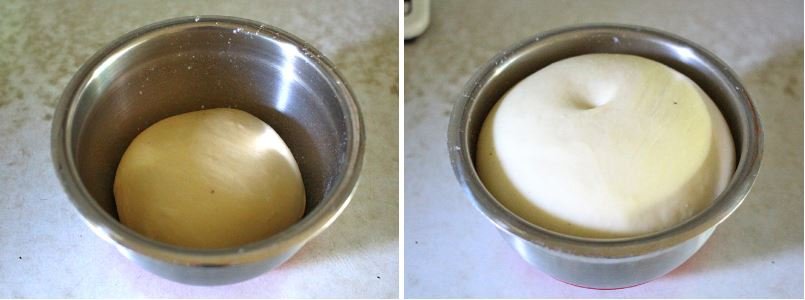 STEP 3/6Divide it into 45 grams and make a circle. Then, cover the wet cotton cloth at room temperature and ferment for 10 to 15 minutes.
STEP 3/6Divide it into 45 grams and make a circle. Then, cover the wet cotton cloth at room temperature and ferment for 10 to 15 minutes.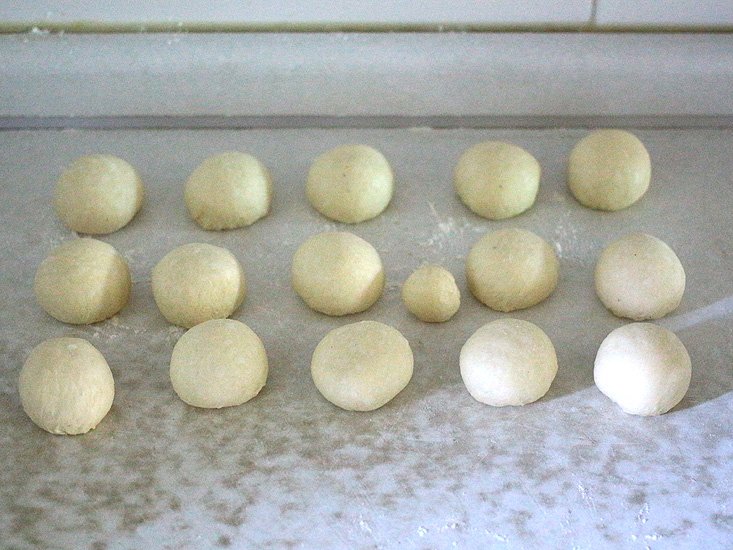 STEP 4/6When the intermediate fermentation is completed, mold it into a twisted bread stick shape. Push it down to 30 cm long, fold it in half to make room, and roll it from top to bottom with your hands. Pinch the ends well. That way, it doesn't happen when you fry it later.
STEP 4/6When the intermediate fermentation is completed, mold it into a twisted bread stick shape. Push it down to 30 cm long, fold it in half to make room, and roll it from top to bottom with your hands. Pinch the ends well. That way, it doesn't happen when you fry it later. STEP 5/6Fanning and second fermentation. If you inflate 1.5 to 1.8 times in a warm place, fermentation is complete. You have to be careful not to over-fermented I had a sore throat at 35 to 38 degrees for about 25 minutes
STEP 5/6Fanning and second fermentation. If you inflate 1.5 to 1.8 times in a warm place, fermentation is complete. You have to be careful not to over-fermented I had a sore throat at 35 to 38 degrees for about 25 minutes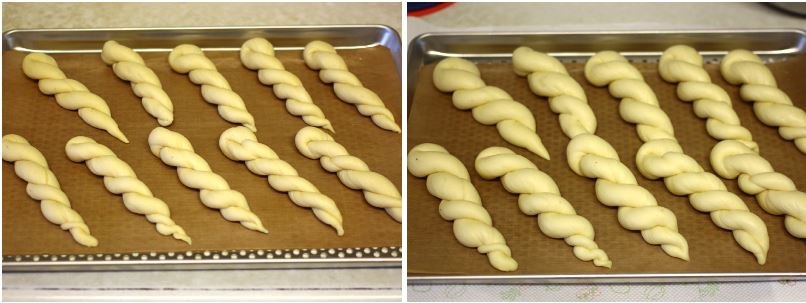 STEP 6/6Heat the frying oil before the dough completes its second fermentation. When the temperature reaches 170-180 degrees, add the fermented dough one at a time and fry until the side is yellowish. If you flip it often, it eats oil and becomes a damp doughnut. When one side is cooked, cook the other side. Place it on a kitchen towel to drain some oil, mix with cinnamon and sugar, and coat the surface evenly
STEP 6/6Heat the frying oil before the dough completes its second fermentation. When the temperature reaches 170-180 degrees, add the fermented dough one at a time and fry until the side is yellowish. If you flip it often, it eats oil and becomes a damp doughnut. When one side is cooked, cook the other side. Place it on a kitchen towel to drain some oil, mix with cinnamon and sugar, and coat the surface evenly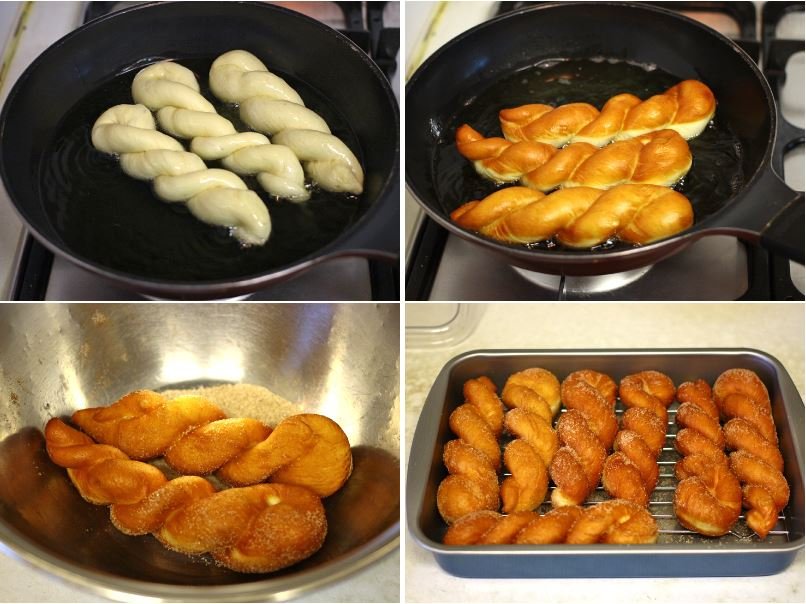
- Cooking review
-
5.00score
-
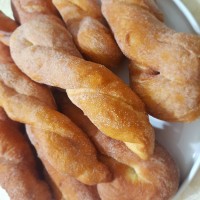 735*****scoreIt's really delicious^^ Thank you for the recipe~~2018-01-25 12:02
735*****scoreIt's really delicious^^ Thank you for the recipe~~2018-01-25 12:02
-
- chicken Recommended recipe
-
-
1
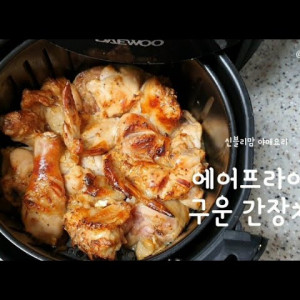 How to make air fryer chicken/soy sauce chicken5.00(10)
How to make air fryer chicken/soy sauce chicken5.00(10) -
2
 [Simple] Make delicious side dishes with leftover chicken5.00(11)
[Simple] Make delicious side dishes with leftover chicken5.00(11) -
3
 Goobne chicken style without failure to make soy sauce chicken!!5.00(6)
Goobne chicken style without failure to make soy sauce chicken!!5.00(6) -
4
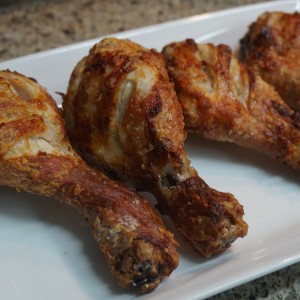 Super simple chicken leg chicken (feat. air fryer)4.75(8)
Super simple chicken leg chicken (feat. air fryer)4.75(8)
-
- stir-fried Rice Cake Recommended recipe
-
-
1Pure Tteok-bokki recipe. Super simple 10 minute tteok-bokki4.85(95)
-
2
 Tteokbokki with Jongwon Baek4.88(97)
Tteokbokki with Jongwon Baek4.88(97) -
3
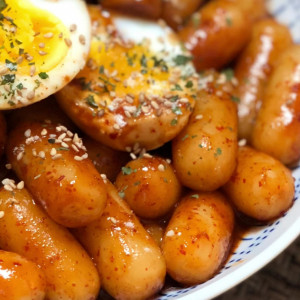 Super simple "Jongwon Baek style tteokbokki" (feat. the end of t4.94(54)
Super simple "Jongwon Baek style tteokbokki" (feat. the end of t4.94(54) -
4
 Golden recipe for tteokbokki. If you do it like this, you'll suc4.88(399)
Golden recipe for tteokbokki. If you do it like this, you'll suc4.88(399)
-